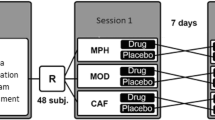Glutamate, the main excitatory neurotransmitter in the mammalian CNS, acts via ionotropic and metabotropic receptors. Results from in vitro studies demonstrating tight interactions between ionotropic NMDA receptors and subtype 5 metabotropic glutamate receptors (mGlu5) have shown that blockade of mGlu5 receptors increases the behavioral effects of NMDA receptor antagonists. The aim of the present work was to study the actions of the highly selective mGlu5 receptor antagonist MTEP alone and in combination with MK-801, a blocker of the NMDA receptor-associated ion channel, on performance of a delayed selection task (a test of working memory) in rats. MK-801 (0.1 mg/kg) induced a specific impairment to working memory, with proactive interference (degradation of the ability to remember current information because of the effects of previously learned material). Administration of MTEP (5.0 mg/kg) combined with both solvent and with MK-801 had no significant effects, demonstrating the small or nonexistent involvement of mGlu5 receptors in the mechanisms of working memory.
Similar content being viewed by others
References
J. J. Anderson, S. P. Rao, B. Rowe, D. R. Giracello, G. Holtz, D. F. Chapman, L. Tehrani, M. J. Bradbury, N. D. Cosford, and M. A. Varney, “[3H]Methoxymethyl-3-[(2-methyl-1,3-thiazol-4-yl)ethynyl] pyridine binding to metabotropic glutamate receptor subtype 5 in rodent brain: in vitro and in vivo characterization,” J. Pharmacol. Exp. Ther., 303, 1044-1051 (2002).
U. C. Campbell, K. Lalwani, L. Hernandez, G. G. Kinney, P. J. Conn, and L. J. Bristow, “The mGluR5 antagonist 2-methyl-6-(phenylethynyl)-pyridine (MPEP) potentiates PCP-induced cognitive deficits in rats,” Psychopharmacology, 175, 310–318 (2004).
P. J. Conn and J. P. Pin, “Pharmacology and functions of metabotropic glutamate receptors,” Ann. Rev. Pharmacol. Toxicol., 37, 205–237 (1997).
N. D. Cosford, J. Roppe, L. Tehrani, E. J. Schweiger, T. J. Seiders, A. Chaudary, S. Rao, and M. A. Varney, “[3H]-methoxymethyl-MTEP and [3H]-methoxy-PEPy: potent and selective radioligands for the metabotropic glutamate subtype 5 (mGlu5) receptor,” Med. Chem. Lett., 13, 351–354 (2003).
N. D. Cosford , L. Tehrani, J. Roppe, E. Schweiger, N. D. Smith, J. Anderson, L. Bristow, J. Brodkin, X. Jiang, I. McDonald, S. Rao, M. Washburn, and M. A. Varney, “3-[(2-Methyl-l,3-thiazol-4-yl)ethynyl]-pyridine: a potent and highly selective metabotropic glutamate subtype 5 receptor antagonist with anxiolytic activity,” J. Med. Chem., 46, 204–206 (2003).
R. Dingledine, K. Borges, D. Bowie, and S. F. Traynelis, “The glutamate receptor ion channels,” Pharmacol. Rev., 51, 7–61 (1999).
S. B. Dunnett and F. L. Martel, “Proactive interference effects on short-term memory in rats: I. Basic parameters and drug effects,” Behav. Neurosci., 104, No. 5, 655–665 (1990).
S. M. Fitzjohn, A. J. Irving, M. J. Palmer, J. Harvey, D. Lodge, and G. L. Collingridge, “Activation of group I mGluRs potentiates NMDA responses in rat hippocampal slices,” Neurosci. Lett., 203, No. 26, 211–213 (1996).
C. A. Heidbreder, M. Bianchi, L. P. Lacroix, S. Faedo, E. Perdona, R. Remelli, P. Cavanni, and F. Crespi, “Evidence that the metabotropic glutamate receptor 5 antagonist MPEP may act as an inhibitor of the norepinephrine transporter in vitro and in vivo,” Synapse, 50, 269–276 (2003).
S. A. Henry, V. Lehmann-Masten, F. Gasparini, M. A. Geyer, and A. Marcou, “The mGluRS antagonist MPEP, but not the mGluR2/3 agonist LY314582, augments PCP effects on prepulse inhibition and locomotor activity,” Neuropharmacology, 43, 1199–1209 (2002).
H. Homayoun, M. R. Stefani, B. W. Adams, G. D. Tamagen, and B. Moghaddam, “Functional interaction between NMDA and mGlu5 receptors: effects on working memory, instrumental learning, motor behaviors, and dopamine release,” Neuropharmacology, 29, 1259–1269 (2004).
P. M. Lea and A. I. Faden, “Metabotropic glutamate receptor subtype 5 antagonists MPEP and MTEP,” CNS Drugs Revs., 12, No. 2, 149–166 (2006).
T. Makovski and Y. V. Jiang, “Proactive interference from items previously stored in visual working memory,” Mem. Cognit., 36, No. 1, 43–52 (2008).
Y. Novitskaya and A. Y. Bespalov, “Proactive interference induced by NMDA receptor channel blockade in working memory task in rats,” Psychopharmacology (2009).
D. M. O’Leary, M. Movsesyan, S. Vicini, and A. I. Faden, “Selective mGluR5 antagonists MPEP and SIB-1893 decrease NMDA or glutamate-mediated neuronal toxicity through actions that reflect NMDA receptor antagonism,” Brit. J. Pharmacol., 131, 1429–1437 (2000).
S. Park and P. S. Holzman, “Schizophrenics show spatial working memory deficits,” Arch. Gen. Psychiatry, 49, 975–982 (1992).
M. Pietraszek, A. Gravius, D. Schäfer, T. Weil, D. Trifanova, and W. Danysz, “mGluRS, but not mGluRl, antagonist modifies MK-801-induced locomotor activity and deficit of prepulse inhibition,” Neuropharmacology, 49, No. 1, 73085 (2005).
S. Sahai, “Glutamate in the mammalian CNS,” CNS Eur. Arch. Psychiatry Clin. Neurosci., 240, No. 2, 121–133 (1990).
R. Shigemoto, S. Nomura, H. Ohishi, H. Sugihara, S. Nakanishi, and N. Mizumo, “Immunohistochemical localization of a metabotropic glutamate receptor, mGluR5, in the rat brain,” Neurosci. Lett., 26, No. 163, 53–57 (1993).
Author information
Authors and Affiliations
Corresponding author
Additional information
Translated from Zhurnal Vysshei Nervnoi Deyatel’nosti imeni I. P. Pavlova, Vol. 59, No. 4, pp. 446–452, July–August, 2009.
Rights and permissions
About this article
Cite this article
Novitskaya, Y.A., Dravolina, O.A., Zvartau, E.E. et al. Interaction of Blockers of Ionotropic NMDA Receptors and Metabotropic Glutamate Receptors in a Working Memory Test in Rats. Neurosci Behav Physi 40, 807–811 (2010). https://doi.org/10.1007/s11055-010-9330-4
Received:
Accepted:
Published:
Issue Date:
DOI: https://doi.org/10.1007/s11055-010-9330-4




